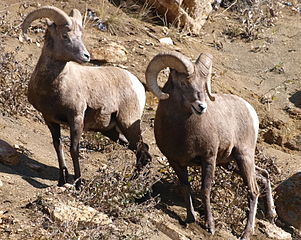Why keep bad alleles? A lesson from Bighorn Sheep.
Subject areas: Genetics, Evolution
Vocabulary:
Gene – The basic unit of inheritance. It is a segment of an organism’s DNA that encodes the production of a physical substrate (often protein or RNA) that governs a particular trait.
Allele – An allele is one version of a gene. Every animal has two copies of each gene – one from its mother, and one from its father. For a particular species, there may be (but not necessarily) more than one version of any given gene.
The article:
Johnston, S.E. et al. Nature doi:10.1038/nature12489
Summary:
Bighorn sheep use the size of their horns as a sign of dominance, and females prefer to mate with the dominant males. Leading up to the rutting season, (and at other times) males engage in dominance battles in which they charge into each other, often head to head.
The authors have previously shown that bighorn sheep have at least two alleles that govern horn size in males: Ho+, which produces larger horns, and HoP, which produces smaller horns. Around half of males that are homozygous for HoP (both Ho genes are the HoP allele) have very small horns called scurs. So, although having two HoP alleles does not automatically lead to small horns and a lower chance of reproductive success, it is a greatly increased probability.
In its most basic sense, evolutionary fitness is about reproduction, so why does the HoP gene still exist? Shouldn’t sheep with HoP alleles have died out over time? Here are a couple of possibilities (but not the only ones). (1) The gene for horn size is part of a group of genes related to male reproductive fitness, so as other genes are being selected for evolutionarily, the Ho alleles are carried along. (2) The HoP gene has another non-horn-size effect that increases reproductive fitness.
In fact, it turns out that rams homozygous for HoP have a significantly higher chance on surviving the harsh winter than rams that are homozygous for Ho+. Although that is not an advantage for a single mating event, it does mean that those HoP rams are more likely to be around to mate for more mating seasons. Still, even if they are around, if no ewes want to mate with them, that would seem unlikely to maintain the gene in the population. The key is in the heterozygotes: the males with one Ho+ allele and one HoP allele.
Heterozygotes have, on average, an intermediate horn size but that allows them a fair amount of reproductive success. In combination with an increased lifespan (=more opportunities for reproduction), overall, they are actually slightly more fit, evolutionarily speaking, than the Ho+/Ho+ homozygotes with the bigger horns.
The take-home message is that the existence of seemingly disadvantageous alleles is not as illogical as it may seem at first glance.


No comments
Be the first one to leave a comment.